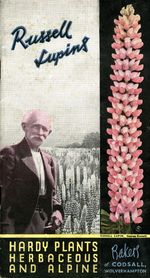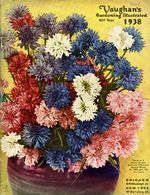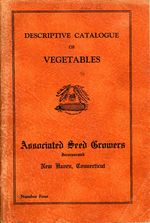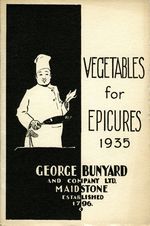“This is the American way of life. Families rearing their children in well-ordered homes, beautified by glowing banks of colorful flowers with neatly laid-out vegetable patches supplying the table all summer—with plenty to spare for canning to enjoy during the winter months”.
Wm. Henry Maule Seed Catalogue 1939-40
A tremendous selection of hardy plants was still available in the 1930s, including many new hybrids of delphiniums, roses, gladioli, irises, bulbs, and peonies, with many catalogues devoted to one or a few species. The catalogues of R. Murrell and Orpington Irises provide information on the raiser and year of introduction of varieties. A notable hardy plant introduction of the 1930s was the Russell lupine, which was hybridized by the amateur breeder John Russell, and introduced with much fanfare by Baker’s in 1937. The cover of the 1938 Baker’s catalogue shows the endearing octegenarian John Russell in his allotment plot of brilliant lupines.
As breeders gained an increasingly advanced understanding of the science of hybridization, they developed many new vegetable and annual flower seed varieties, along with new strategies to market them. The All-America Selections was established in 1932, both to evaluate and publicize new introductions. Catalogues of the 1930s promoted new varieties of colorful annuals for cutting and bedding such as bachelor’s buttons, cosmos, godetias, marigolds, nasturtiums, petunias and zinnias. Vaughan’s Seed Store of Chicago, founded in 1876, listed many new All-America Selections in its catalogue of 1938, as well as rust-resistant snapdragons developed at the University of California.
During the 1930s, scientists at universities and agricultural experiment stations developed new F1 hybrid corn varieties, many of which were sold by seed companies. Large seed firms also employed their own breeders to develop vigorous and productive F1 hybrid and open-pollinated strains of vegetables specifically adapted to different areas of the country or resistant to particular diseases. The Asgrow catalogue of 1937 explains this new, comprehensive approach. Although the Asgrow catalogue contains many open-pollinated vegetables, they list recently-developed varieties of hybrid corn, with descriptions that mention the wide range of scientists and institutions involved in their development.
A particularly delightful seed catalogue from the 1930s is Edward A. Bunyard’s 1935 Vegetables for Epicures, illustrated by Francis Bunyard. In a lament that recalls modern gourmet vegetable catalogue complaints about supermarket vegetables, Bunyard wrote, “Too long have vegetables been chosen for such majestic contours as would assure a prize at the vegetable show”. This catalogue, which Bunyard mentions was the fifth edition, may be one of the earliest catalogues with a selection of vegetables deliberately chosen for flavor.1
Box 22 of the OSU Seed and Nursery Trade Catalogue collection contains botanic garden seed lists from Europe, Eastern Europe and Asia from 1934-1935, which were sent upon request to the Lexington Botanic Garden in Massachusetts. The lists show the seeds that the gardens had available for exchange, and document the range of plants available before the outbreak of the Second World War. Many of the gardens’ collections may not have survived the war.




